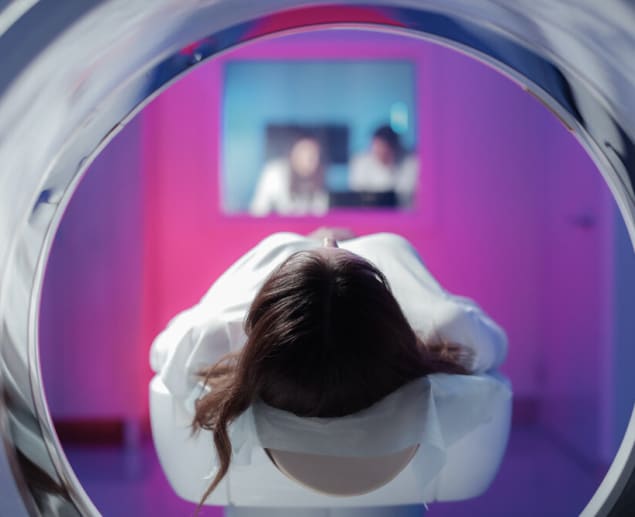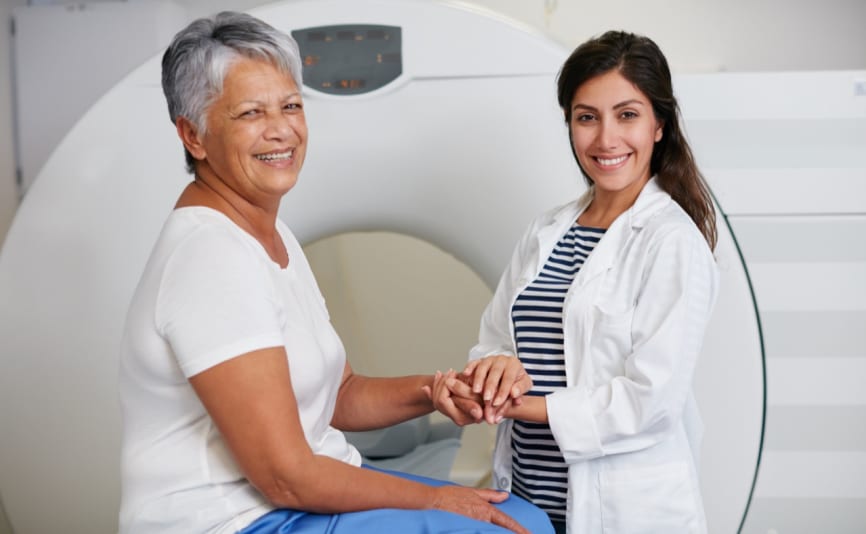Magnetic Resonance Imaging (MRI) technology has become one of the most valuable diagnostic tools in modern medicine. It’s a medical imaging technique that uses magnetic fields and radio waves to generate highly detailed images of the body’s internal structures.
An MRI scan is particularly effective at examining soft tissues, organs, and blood vessels, allowing healthcare professionals to detect critical conditions such as cancer and neurological disorders at an early stage, as well as identify abnormalities that may require further evaluation.
Each year, over 4 million MRI scans are performed in the UK. However, many people experience anxiety about the procedure. If you have been advised to undergo an MRI, you may have concerns about what to expect and whether there are any risks involved.
Fortunately, MRI is one of the safest medical technologies available, with minimal risks. Much of the fear around MRI scans stems from misinformation and confusion with other imaging techniques, leading to widespread MRI myths.
In this guide, we debunk 11 of the most common myths and misconceptions about MRI technology.
1. An MRI Scan Uses Dangerous Radiation
One of the most common myths about MRI scans is that they involve harmful radiation. This misconception arises because many people confuse MRI with other imaging techniques that do use radiation - such as X-Rays, Computed Tomography (CT) scans, and Positron Emission Tomography (PET) scans - or mistakenly group them all together.
The term radiologist, which refers to the medical specialist who interprets imaging scans, may also contribute to this confusion.
In reality, MRI scanners operate using powerful magnets and bursts of radio wave energy, neither of which have harmful effects on the human body.
By contrast, X-Rays, CT scans, and PET scans use low doses of ionising radiation, which can slightly increase the risk of cancer with repeated exposure. This is one of the key reasons why MRI is the preferred imaging method for examining soft tissues and organs whenever possible.
2. MRI Exams Damage All Medical Implants
Another common MRI myth is that patients with medical implants cannot undergo the procedure.
While it’s true that certain metal implants can interfere with MRI’s magnetic fields and radio waves - potentially causing malfunctions or displacement - many implants are entirely safe.
These include non-metal implants and modern titanium implants, which are MRI-compatible. Dental fillings and crowns are also unaffected by MRI scans.
If you have any implants, it’s important to inform the imaging centre in advance. They will assess whether your implant is MRI-compatible. If it is not, they may suggest an alternative imaging method, such as a CT scan.
Some facilities also offer low-magnetic-field (0.55T) MRI machines, which can be used for specific cases.
Items that are typically not suitable for MRI scans include:
- Pacemakers
-
Aneurysm clips
-
Older cochlear implants (though newer, titanium-based ones are often MRI safe)
-
Metal plates, rods, or screws
-
Defibrillators
-
Bullets or shrapnel lodged in the body
Additionally, you will need to remove any external metal objects, such as piercings or jewellery, before the scan.
You can consult with your imaging centre or check here for information on what is generally considered safe, unsafe, or conditionally safe for an MRI scan.
3. Contrast Dye Used In MRI Scans Is Dangerous
Some MRI scans require a contrast agent, typically administered via injection or IV drip, to enhance image clarity.
Contrast dyes are most commonly used in MRI scans for cancer detection or neurological disorders, as they help differentiate between healthy and abnormal tissues. The dye used in MRI scans is a gadolinium-based agent.
Another of the common MRI myths is that these agents cause harmful side effects. In reality, they are considered very safe. While a small percentage of patients may experience minor side effects - such as dizziness, an itchy rash, or nausea - these are rare and usually temporary. In fact, gadolinium-based contrast agents are less likely to cause adverse effects than the iodine-based contrast agents used in CT scans.
Severe side effects are extremely rare, occurring in fewer than 1 in 1,000 patients. However, individuals with severe kidney disease are at higher risk of developing Nephrogenic Systemic Fibrosis (NSF), a condition which thickens tissues, organs, joints, and skin. Due to this risk, contrast dye is generally avoided in patients with advanced kidney disease.
To minimise the likelihood of minor side effects, patients are typically advised to avoid eating or drinking for a few hours before a contrast-enhanced MRI scan and to stay well hydrated afterwards to help flush the dye from their system.
4. All MRIs Are The Same
MRI machines and scans vary in several ways. The machines themselves come in different types, each designed for specific needs.
The standard MRI scanner is a horizontal, 60cm-wide tube that is closed at one end. Patients lie on a bed that moves into the scanner. Other types of MRI scanners include:
- Wide bore MRI scanners - these have a wider 70cm tube, making them more comfortable for larger individuals.
-
Open MRI scanners - featuring a C-shaped design instead of a tube, these are ideal for patients who experience claustrophobia.
-
Upright MRI scanners - these allow scanning in a sitting or standing position, making them suitable for individuals with mobility issues. They can also detect conditions that appear only when the body is in a weight-bearing position.
MRI machines also differ in magnetic field strength. The standard 1.5 Tesla (T) scanner is widely used, but there are other options:
- 3T MRI scanners provide higher resolution images for more detailed diagnostics.
-
0.55T MRI scanners produce lower magnetic field strength, reducing interference from metal objects.
MRI scans can also vary in purpose. A scan can cover the entire body or focus on a specific area. Additionally, specialised MRI scans capture images in real time, including:
- Functional MRI (fMRI) - measures blood flow in the brain to assess brain activity.
-
MR Angiography (MRA) - examines blood flow through arteries supplying the body’s organs.
-
MR Venography (MRV) - evaluates blood flow in veins and detects blood clots.
5. Pregnant Women Can’t Have An MRI
Despite concerns about MRI risks during pregnancy, there is no evidence that MRI scans harm either the mother or baby. The risks associated with contrast dye use in pregnant women are also minimal.
Studies show that less than 0.04% of the administered gadolinium dose reaches breast milk, and less than 1% of that is ingested by the infant.
That said, doctors generally avoid recommending an MRI scan during the first trimester as a precautionary measure. Contrast dye is also typically avoided during pregnancy unless absolutely necessary. Healthcare professionals assess the need for MRI scans in pregnant women on a case-by-case basis. If you have any concerns, you can speak to your GP.
Another common MRI myth is that scans increase the risk of infertility. Since MRI technology does not use radiation, there is no risk of infertility.
6. You Can’t Have an MRI if You Have Claustrophobia
The stereotypical image of an MRI machine is a tightly enclosed, noisy space where patients must remain still for long periods. Because of this, MRI scans are often associated with claustrophobia, leading many to believe they are unsuitable for individuals with a fear of enclosed spaces.
However, technological advancements have made MRI scans a lot more accessible and comfortable for those with claustrophobia. Many facilities now offer wide-bore or open MRI machines, which provide more space and reduce the feeling of confinement.
Additionally, improvements in MRI technology have led to faster scan times, minimising discomfort
If you experience claustrophobia and are concerned about your MRI scan, you can speak with the staff beforehand to explore options that can help you relax. These may include:
- Mild sedatives to ease anxiety
-
Headphones with soothing music to reduce noise and create a calming atmosphere
-
Cushions and pads for added comfort
During the scan, you will also have access to a two-way intercom, allowing you to communicate with the radiographer at any time if you feel uneasy or need assistance.
7. MRI Scans Are Only For Brain Imaging
MRI scans produce high-resolution images of the body’s soft tissues, organs, and blood vessels. They are used to detect a wide range of health issues and conditions across various parts of the body, including in the brain, heart, lungs, abdomen, and spinal cord.
Beyond neurological disorders, MRI scans can help diagnose conditions such as:
8. MRI is Painful and Uncomfortable For Everyone
Most people do not experience pain or discomfort during an MRI scan. Only about 10% report feelings of claustrophobia. MRI scans are non-invasive and do not involve any surgical procedures.
One common concern is noise, as the magnets and radio waves produce buzzing and managing sounds that can reach approximately 120dB. However, this is managed with noise-cancelling headphones or earplugs.
Pain is typically only an issue for patients with mobility limitations or chronic conditions, but this is mitigated by specialised wide-bore and open MRI scanners, as well as foam padding and cushions for added comfort.
If you feel pain or discomfort during your scan, you can inform the radiographer immediately using the two-way intercom.
9. You Can’t Have an MRI if You Have Tattoos
Some tattoo inks contain metallic pigments, leading to confusion - and even myths - about their safety during MRI scans.
In reality, the traces of metal are too small to disrupt magnetic fields or interfere with MRI machinery. If you have tattoos, the most you might experience is mild irritation or a slight warming sensation around the tattoo. However, studies suggest that fewer than 1% of people with tattoos encounter any issues during an MRI scan.
If you’re concerned about the potential effects, you can speak with the MRI staff beforehand. They can often provide damp towels or cold packs to minimise any discomfort.
10. MRI Machines Can Read Your Mind
One of the most intriguing MRI myths is that scans can read your mind. In reality, MRI technology is nowhere near that advanced. A standard brain MRI produces highly detailed still images that help medical professionals diagnose neurological conditions or detect illnesses.
Functional MRI (fMRI) takes this a step further by measuring blood flow, allowing researchers to map brain activity and identify which areas are engaged during different cognitive or emotional tasks. However, fMRI cannot “read” thoughts or determine exactly what a person is thinking.
11. MRI Scans Are Always Expensive
MRI scans are often perceived as expensive, likely due to the advanced technology involved. However, you don’t have to break the bank to get one. In fact, if you are referred by a doctor or specialist healthcare provider, MRI scans are available for free on the NHS.
Private scans start at around £300 and are often covered by private health insurance if deemed medically necessary.
If you are considering paying out of pocket for an MRI, it’s worth weighing the benefits against the cost. A preventative scan might not seem like good value if you have no symptoms, but for those in high-risk groups, it could potentially save both time and money on future medical treatment.
Get An MRI Scan
You can book a private MRI scan with us without needing a GP referral. The process takes just a few minutes - simply complete a short online form and choose a convenient scanning location. A specialist clinician will be assigned to you to guide you through the process, explain your scan results, and assist with any necessary next steps.
Sources
- https://www.sciencedirect.com/science/article/abs/pii/S0037198X17300123
-
https://www.health.harvard.edu/cancer/radiation-risk-from-medical-imaging
-
https://www.win.ox.ac.uk/files/research-facilities/3t_surgery_and_implant_safe_list.pdf
-
https://rarediseases.org/rare-diseases/nephrogenic-systemic-fibrosis/
-
https://stanfordhealthcare.org/medical-tests/m/mri/types/mrv.html
-
https://www.sciencedirect.com/science/article/pii/S1078817423002067
-
https://www.healthimages.com/can-you-get-an-mri-with-a-tattoo/
-
https://www.scientificamerican.com/article/can-you-tell-someones-emotional-state-from-an-mri/







